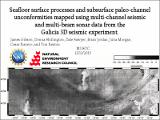Por favor, use este identificador para citar o enlazar a este item:
http://hdl.handle.net/10261/141057COMPARTIR / EXPORTAR:
 SHARE
BASE SHARE
BASE
|
|
| Visualizar otros formatos: MARC | Dublin Core | RDF | ORE | MODS | METS | DIDL | DATACITE | |

| Título: | Seafloor surface processes and subsurface paleo-channel unconformities mapped using multi-channel seismic and multi-beam sonar data from the Galicia 3D seismic experiment |
Autor: | Gibson, James; Shillington, Donna; Sawyer, Dale; Jordan, Brian; Morgan, Julia; Ranero, César R. CSIC ORCID; Reston, Timothy | Fecha de publicación: | 15-dic-2015 | Editor: | American Geophysical Union | Citación: | AGU Fall Meeting 2015: T33D-2970 (2015) | Resumen: | In this study we use geophysical methods, stratigraphic relationships, and coring/drilling leg results to assess possible controls on deep-sea channel formation in order to further constrain paleo-channel (PC) and associated unconformity timing/source processes. A series of cut and fill PC are mapped in 3D multi-channel seismic (MCS) data and compared with multi-beam (MB) sonar bathymetry/backscatter data collected during the Galicia 3D survey with the R/V Marcus G. Langseth (2013). The MCS data were collected using four 6 km streamers spaced at 200 m resulting in 25 m x 25 m common mid-point bins within the ~67 km x 20 km 3D volume. The MB data were collected at an average depth of ~4900 m with a constrained swath width of 4.5 km resulting in 11.25x overlap while enabling 25-m bathymetry and 10-m backscatter grids. The PC lie below the mouth of a submarine canyon at the edge of the Galicia abyssal plain and cut pre/syn-rift sediments; they are bound by a rift block to the north and paleo-levees to the south (maximum height of ~180m). From drilling results, the most recent PC is late Miocene in age. In this study, four PC are traced into the basin as unconformities. Several of the PC/unconformities are tentatively correlated with previously interpreted Pyrenean orogeny/compressional Miocene/Oligocene tectonic events. However, one PC/unconformity within this interval has not been previously interpreted. In order test the hypothesis that the unconformities are the result of a significant change in base level indicated by a low shale/sand (SS) ratio, we use seismic surface attributes to calculate the SS ratio and trace the horizontal extent of the unconformities. Additionally, the MB/MCS seafloor morphology reveals sedimentary waves outboard of the canyon mouth. We use backscatter data to compare the extent of recent processes (e.g., Pleistocene glaciation/de-glaciation) with the unconformities by mapping the surface/shallow subsurface SS ratio (volume scattering) | Descripción: | American Geophysical Union (AGU) Fall Meeting, 14-18 December 2015, San Francisco | Versión del editor: | https://agu.confex.com/agu/fm15/webprogram/Paper80180.html | URI: | http://hdl.handle.net/10261/141057 |
| Aparece en las colecciones: | (ICM) Comunicaciones congresos |
Ficheros en este ítem:
| Fichero | Descripción | Tamaño | Formato | |
|---|---|---|---|---|
| Gibson_et_al_2015_presentacion.pdf | 20,51 MB | Adobe PDF |  Visualizar/Abrir |
CORE Recommender
Page view(s)
190
checked on 17-abr-2024
Download(s)
91
checked on 17-abr-2024
Google ScholarTM
Check
NOTA: Los ítems de Digital.CSIC están protegidos por copyright, con todos los derechos reservados, a menos que se indique lo contrario.
